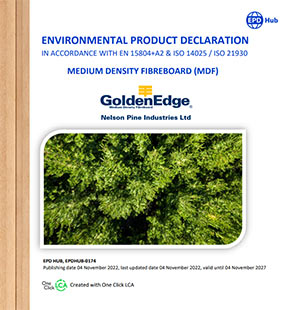How MDF is made
Forests: The Nelson region of New Zealand has 175,000 hectares of plantation forests, primarily radiata pine. 100% of our raw material comes from these plantation forests. We own 2100 hectares of forests ourselves, and buy the remainder of our needs from other forest owners. New Zealand’s exotic Radiata pine forests provide a quality of fibre uniquely suited to the production of Medium Density Fibreboard. Logs arrive on site from the forests and leave as a range of MDF products tailored to market needs worldwide.
Log Yard: Pulp and veneer logs are delivered to our log yard for both the MDF and LVL processes. We receive close to one million m3 of logs per year, which is an average of 170 log trucks per day.
Debarking & chipping: Logs are unloaded from trucks to be processed at the chipmill. Two rotary cranes and a 27 metre drum debarker handle more than 300 tonnes of logs per hour. Directly after debarking the logs are fed through a disc chipper. Woodchips are stored in chip piles prior to washing to remove stones and sand.
Fibre processing: Woodchips are heated with steam and separated into individual cellulose fibres using a disc refiner. After refining, resin and wax are mixed with the fibres in a steam blow line that conveys the fibre to the flash drier.
Pressing: The dried fibres are formed into mats and processed through presses. The use of continuous press technology, pioneered by Nelson Pine Industries in the Southern Hemisphere has been a key factor in securing the high reputation and dominant market position of the GoldenEdge product.
Sanding: Staying at the forefront of technology continues to be part of the company ethos, and in 2008 there was a significant investment to upgrade the finishing line, where the board is sanded and packed. The new Steinemann sander has 14 heads, comprising six calibrating heads, six finishing heads and two super finishing brushes, with sanding at rates up to 150 metres per minute. Because the extra heads allow a gradual reduction in grit courseness the finish of the sanded MDF sets a new standard internationally.
Sawing: From the sander the board moves to the Anthon cut to size saw, then two large robots transfer the made up packs to the strapping line. The new finishing line puts NPIL a step ahead in the growing market demand for harder surfaced, high quality MDF.
Added Value: A further processing facility converts panels into moulded products used as an alternative to dressing grade timber in the building and furniture industry. These moisture resistant mouldings are predominantly sold in the New Zealand market.
Research and Development
The R&D programme aims to improve the quality of product to meet and anticipate market demands, with a focus on:
- Low formaldehyde emissions
- Lightweight MDF
- Moisture resistance
- International requirements
- Quality assurance
Low fuming formaldehyde emissions
Research carried out in conjunction with resin suppliers, has enabled us to reduce the formaldehyde levels in our Medium Density Fibreboard to the point where all GoldenEdge product is marketed with low fuming formaldehyde emissions. Recent developments have enabled NPI to produce a full range of thickness to meet the new Japanese F**** standard which is the lowest emission standard in the world. We are also certified to meet the American CARB phase 2 standard for low formaldehyde emission board. All GoldenEdge product carries the Eco Choice Aotearoa Certification and the New Zealand product range is certified FSC™ mixed source.

View the MDF process in a flowchart format
Production Process Flowchart (PDF)GoldenEdge® MDF Environmental Product Declaration

